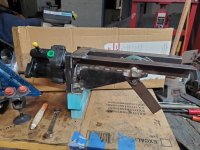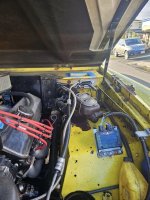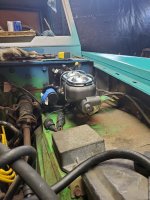I’ve been reading a lot of the great posts on the forum about disk brake upgrades that have big caliper pistons and folks ending up going to bigger MC bore to get back to decent pedal travels. I’m not super happy with my pedal travel and based on all my reading, I was thinking of going to a new MC with 1.25” bore. But was also looking at pedal ratio (travel) as a possible improvement.
My general thinking is that upgrading to large diameter pistons in disk calipers versus drum brake wheel cylinders obviously requires more brake fluid to flow which can be solved by bigger bore MC as many have done. But MC stoke seems like it plays a pretty big factor so I’ve been trying to determine what pedal ratio I want if I modify my pedal.
I picked up a pedal that I could measure fairly closely ( thanks @904Bronco ) and the pedal ratio is about 5.8. Given a roughly reasonable pedal height of 5 inches and maybe 4 inches of travel before bottoming on floorboard says I’ll get about 0.68” of MC stroke at full travel. That seems way too low amount of MC stroke to me.
Anybody have any info on typical max stroke for MCs? I know most say to not stoke more than 1” when bench bleeding (by the way, anybody know where that comes from)? (best I can figure out is most domestic MCs have a full stroke of 1.5 to 1.75”)
Clearly there’s a lot to sort out like maintaining good pushrod alignment with moving the attach point on pedal, but wanted to see if I was barking up the wrong tree on getting more MC stroke as a possible contributor to getting better pedal versus only MC bore.
My general thinking is that upgrading to large diameter pistons in disk calipers versus drum brake wheel cylinders obviously requires more brake fluid to flow which can be solved by bigger bore MC as many have done. But MC stoke seems like it plays a pretty big factor so I’ve been trying to determine what pedal ratio I want if I modify my pedal.
I picked up a pedal that I could measure fairly closely ( thanks @904Bronco ) and the pedal ratio is about 5.8. Given a roughly reasonable pedal height of 5 inches and maybe 4 inches of travel before bottoming on floorboard says I’ll get about 0.68” of MC stroke at full travel. That seems way too low amount of MC stroke to me.
Anybody have any info on typical max stroke for MCs? I know most say to not stoke more than 1” when bench bleeding (by the way, anybody know where that comes from)? (best I can figure out is most domestic MCs have a full stroke of 1.5 to 1.75”)
Clearly there’s a lot to sort out like maintaining good pushrod alignment with moving the attach point on pedal, but wanted to see if I was barking up the wrong tree on getting more MC stroke as a possible contributor to getting better pedal versus only MC bore.













